
 New
England Aster (Aster novae-angliae)
New
England Aster (Aster novae-angliae)
Wild Flowers of Sleepy Hollow Lake From All-Creatures.org Art and Photo Journals and Galleries Directory
Dedicated to the Preservation and Restoration of the Whole of Creation: Humans - Animals - Environment
"And God saw all that He had made, and behold, it was very good.
And there was evening and there was morning, the sixth day" (Genesis 1:31)
New England Aster (Aster novae-angliae)
Table of Contents
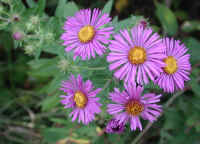
(Aster, New England (Aster novae-angliae) - 01)
We have found that the identification of specific species of asters to be among
the most difficult of all wild flower species. This is because there are
so many different species, and from our research, not even the experts seem to
be able to agree on all aspects of the identification. As we continue, we
will try to explain some of the easier ways to identify the New England aster,
as well as the problems.
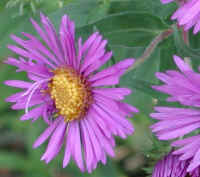
(Aster, New England (Aster novae-angliae) - 01a)
One of the more easily identifiable features of the New England aster is the
large number of purple ray flowers, which should be forty or more. One
source indicated that there could be as many as one-hundred. Another
feature is the hairy stems and leaves, but this characteristic is not mentioned
in most of the sources we reviewed.
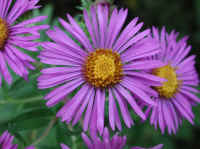
(Aster, New England (Aster novae-angliae) - 02)
On the central flower in this photo, we counted at least 56 purple ray flowers
surrounding the yellow disk. As they open, the disk flowers darken from
yellow to an orange color.
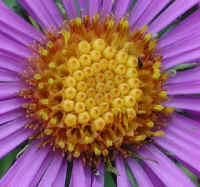
(Aster, New England (Aster novae-angliae) - 02a)
What we normally see as the yellow disk is the bud stage of the disk flowers,
which are clearly visible in this bee's eye view. Around the perimeter of
the disk, we can see the open disk flowers with their stamens and pistil
extending beyond the bowl of the flower.
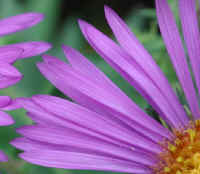
(Aster, New England (Aster novae-angliae) - 02b)
In this close-up photo of the New England aster's ray flowers, we can see
longitudinal veining and the pointed tips. To us, the ray flowers seem to
be narrower than those of the similar New York aster, which also has fewer ray
flowers. This feature, though not mentioned in the literature we reviewed,
helps in identification. The actual length of the ray flowers is about one-half inch.
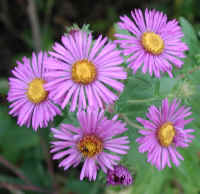
(Aster, New England (Aster novae-angliae) - 03)
The size of the fully opened New England aster flowers is between 1-1/4 and
1-1/2 inches across, placing them among the larger of the wild aster flowers.
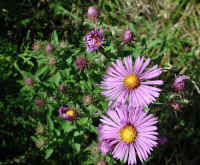
(Aster, New England (Aster novae-angliae) - 04)
In this photo of the New England aster, we can see flowers in various stages of
development from tightly closed buds to nearly fully matured flowers. One
reference stated that the leaves can reach lengths of nearly four inches, but we
have found them to be smaller, as shown in this photo.
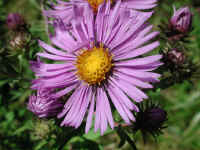
(Aster, New England (Aster novae-angliae) - 05)
This is a fairly mature New England aster surrounded by several budding flower heads.
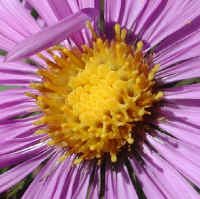
(Aster, New England (Aster novae-angliae) - 05a)
This is a closer look at the disk flowers of the New England aster in the
previous photo. There seems to be no end to the marvelous beauty of God's creation!
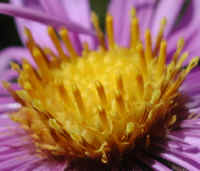
(Aster, New England (Aster novae-angliae) - 06)
In this bee's eye view of the New England aster disk flowers, we can see that
they're far more complex than the seemingly simple yellow center disk we observe
when looking at these wildflowers along the side of the road or in a field.
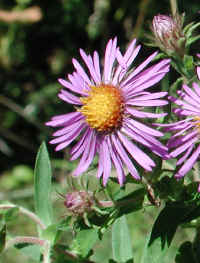
(Aster, New England (Aster novae-angliae) - 07)
In this photo, we can see that the leaves of the New England aster are usually
not much longer than the diameter of the flower. We can also see the very
fine hairs that cover both the leaves and the stems.
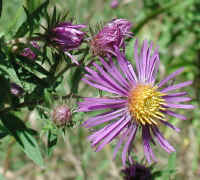
(Aster, New England (Aster novae-angliae) - 07a)
Another look at the beauty of the New England aster.
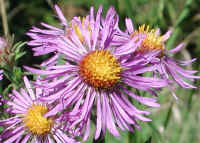
(Aster, New England (Aster novae-angliae) - 07b)
The color of the New England aster ranges from a deep purple, which is unique
among wild asters, to paler shades of purple, which is similar to other asters.
In the latter case, the large number of ray flowers helps in identification.
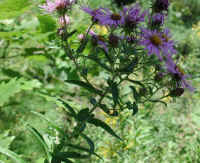
(Aster, New England (Aster novae-angliae) - 08)
In this photo of the New England aster, we can see the way the lanceolate leaves
grow alternately along the stem.
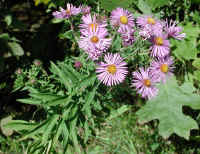
(Aster, New England (Aster novae-angliae) - 09)
According to the literature, the New England aster grows to heights of between
three and seven feet. We have never seen a seven feet tall one, but have
observed that the taller ones seem to be competing for sunlight, while the ones
along the side of the road, where there is plenty of sunlight, usually grow to
heights of only three or four feet.
| Wild Flowers of SHL: Photo Identification, Common Name, Scientific Name | Art and Photos |

 Presented here are just a few of the countless components of God's creation.
Just as we cannot have human and animal life without water and plants, neither
can we have lasting peace without love and compassion. It is our hope and
prayer that this series will motivate people to live and act in a cruelty-free
manner; that we would no longer hurt or destroy each other, the animals or our
environment.
Presented here are just a few of the countless components of God's creation.
Just as we cannot have human and animal life without water and plants, neither
can we have lasting peace without love and compassion. It is our hope and
prayer that this series will motivate people to live and act in a cruelty-free
manner; that we would no longer hurt or destroy each other, the animals or our
environment.







